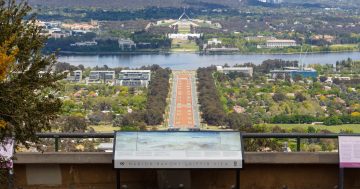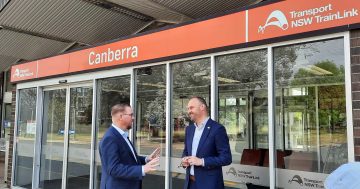
The ‘City of Canberra’ locomotive pulling into Canberra Railway Station. Photo: Dave Coleman.
There wasn’t much to do in Harden when Garry Reynolds went there for family holidays as a kid. After all, there was no pool to swim in or television to watch.
“We did a lot of reading,” he says. “But nearly every evening, dad would take us down to the railway yard to see a train come in. That was entertainment for my brother and I.”
Trains and railways have played a major role in Garry’s life. Since retiring in 2014, he has taken on the job of telling the story of how the railway formed the economic backbone of Australia.
He volunteered as a concierge on train rides for the Canberra Railway Museum until it closed. Despite lobbying the ACT Government for heritage funding, the original contents couldn’t be retained. Even the ‘6029 Beyer-Garratt‘, the largest locomotive in the Southern Hemisphere, named ‘City of Canberra’ only a few months prior, is now in private hands.
Garry realised the general public simply didn’t know what they were losing.
“I wanted to flag to people the importance of conserving rail heritage as crucial to retaining examples of the underlying story of the development of Canberra,” says Garry.

When the ACT isn’t in lockdown, the Canberra Railway Museum is open every Sunday from 10 am t0 3 pm. Photo: Canberra Railway Museum.
He has written six books on various aspects of Australian history although his work has been on hiatus during the past year because he suffered several strokes which put him in hospital in Canberra for four months and rendered him unable to write.
But as part of the physical and mental rehabilitation process, his therapists encouraged Garry to get back into it as soon as he could.
That’s exactly what he has been doing, albeit from the Sunshine Coast, in Queensland, where he is living with his daughter.
In Garry’s latest research, his findings on Walter Burley Griffin’s original plans for Canberra gave him “the shock of [his] life”.
“The story of Walter and Marion Griffin is remarkably different from what you hear at all the tourist places,” says Garry. “They were mad railway fans, and had planned a massive light and heavy rail system for Canberra.”
The Griffins won the competition to design Australia’s new capital city in 1911, and came over from the US city of Chicago to help put it in place.

The ‘City of Canberra’ is the largest locomotive in the Southern Hemisphere. Photo: John Coleman.
“Chicago was the biggest railway centre in America with 32 lines coming in,” says Garry. “They were so used to these rail networks that it was the natural thing to do. If you were building a new city, why wouldn’t you build it around a rail system?”
Canberra’s initial train station was located at Kingston as a temporary and cheap way of bringing in construction materials and coal for the nearby power station, now the Glassworks.
“Walter objected to both pieces of infrastructure as they didn’t fit in with his vision for a grand rail entrance,” says Garry. “Canberra was to be a totally different layout.”
He explains that Griffith, Kingston and Fyshwick were far from industrial estates, but were instead to form a “posh suburb” called Lakeside. The lake in question would be Eastlake, now the Jerrabomberra Wetlands Nature Reserve.
Entry into Canberra would be via a two-track, elevated railway across Eastlake before ending at a four-track underground station in Campbell.
The main station was also going to accommodate a big freight station near where the Australian-American Memorial eagle statue now sits in Russell. This would have serviced produce and materials coming in from Sydney and the regions.

Ironically, the largest rail network in the ACT is the Canberra Miniature Railway. Photo: Canberra Miniature Railway.
Light rail was to run the length of Northbourne Avenue. Only recently that is the only part to have ever seen the light of day.
So what happened to the rest of the grand plan?
Garry says the prevailing story at this point is that the Griffins didn’t get on too well with the bureaucrats overseeing the project. Many thought his plan was overly ambitious for a competition that called for a city with a projected population of 25,000.
Griffin’s plan easily catered for triple that number of people.
But Garry’s investigative mind isn’t completely convinced by this, and is looking into the private lives of the Griffins to provide a definitive and holistic answer as to why Canberra never received its own railway system.
Watch this space.
















